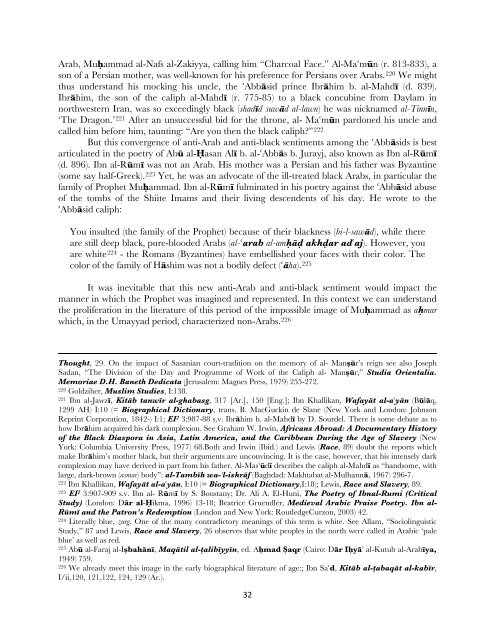“Anyone who says that the Prophet is black should be killed”: The ...
“Anyone who says that the Prophet is black should be killed”: The ...
“Anyone who says that the Prophet is black should be killed”: The ...
You also want an ePaper? Increase the reach of your titles
YUMPU automatically turns print PDFs into web optimized ePapers that Google loves.
Arab, MuÈammad al-Nafs al-Zakiyya, calling him “Charcoal Face.” Al-Ma#mån (r. 813-833), a<br />
son of a Persian mo<strong>the</strong>r, was well-known for h<strong>is</strong> preference for Persians over Arabs. 220 We might<br />
thus understand h<strong>is</strong> mocking h<strong>is</strong> uncle, <strong>the</strong> #Abb§sid prince Ibr§him b. al-MahdÊ (d. 839).<br />
Ibr§him, <strong>the</strong> son of <strong>the</strong> caliph al-MahdÊ (r. 775-85) to a <strong>black</strong> concubine from Daylam in<br />
northwestern Iran, was so exceedingly <strong>black</strong> (shadÊd suw§d al-lawn) he was nicknamed al-TinnÊn,<br />
‘<strong>The</strong> Dragon.’ 221 After an unsuccessful bid for <strong>the</strong> throne, al- Ma#mån pardoned h<strong>is</strong> uncle and<br />
called him <strong>be</strong>fore him, taunting: “Are you <strong>the</strong>n <strong>the</strong> <strong>black</strong> caliph?” 222<br />
But th<strong>is</strong> convergence of anti-Arab and anti-<strong>black</strong> sentiments among <strong>the</strong> #Abb§sids <strong>is</strong> <strong>be</strong>st<br />
articulated in <strong>the</strong> poetry of Abå al-\asan AlÊ b. al-#Abb§s b. Jurayj, also known as Ibn al-RåmÊ<br />
(d. 896). Ibn al-RåmÊ was not an Arab. H<strong>is</strong> mo<strong>the</strong>r was a Persian and h<strong>is</strong> fa<strong>the</strong>r was Byzantine<br />
(some say half-Greek).<br />
223<br />
Yet, he was an advocate of <strong>the</strong> ill-treated <strong>black</strong> Arabs, in particular <strong>the</strong><br />
family of <strong>Prophet</strong> MuÈammad. Ibn al-RåmÊ fulminated in h<strong>is</strong> poetry against <strong>the</strong> #Abb§sid abuse<br />
of <strong>the</strong> tombs of <strong>the</strong> Shiite Imams and <strong>the</strong>ir living descendents of h<strong>is</strong> day. He wrote to <strong>the</strong><br />
#Abb§sid caliph:<br />
You insulted (<strong>the</strong> family of <strong>the</strong> <strong>Prophet</strong>) <strong>be</strong>cause of <strong>the</strong>ir <strong>black</strong>ness (bi-l-saw§d), while <strong>the</strong>re<br />
are still deep <strong>black</strong>, pure-blooded Arabs (al-#arab al-amȧ∙ akh∙ar ad#aj). However, you<br />
are white224<br />
- <strong>the</strong> Romans (Byzantines) have em<strong>be</strong>ll<strong>is</strong>hed your faces with <strong>the</strong>ir color. <strong>The</strong><br />
color of <strong>the</strong> family of H§shim was not a bodily defect (#§ha). 225<br />
It was inevitable <strong>that</strong> th<strong>is</strong> new anti-Arab and anti-<strong>black</strong> sentiment would impact <strong>the</strong><br />
manner in which <strong>the</strong> <strong>Prophet</strong> was imagined and represented. In th<strong>is</strong> context we can understand<br />
<strong>the</strong> proliferation in <strong>the</strong> literature of th<strong>is</strong> period of <strong>the</strong> impossible image of MuÈammad as aÈmar<br />
which, in <strong>the</strong> Umayyad period, characterized non-Arabs. 226<br />
Thought, 29. On <strong>the</strong> impact of Sasanian court-tradition on <strong>the</strong> memory of al- Manßår’s reign see also Joseph<br />
Sadan, “<strong>The</strong> Div<strong>is</strong>ion of <strong>the</strong> Day and Programme of Work of <strong>the</strong> Caliph al- Manßår,” Studia Orientalia.<br />
Memoriae D.H. Baneth Dedicata (Jerusalem: Magnes Press, 1979) 255-272.<br />
220 Goldziher, Muslim Studies, I:138.<br />
221 Ibn al-JawzÊ, Kit§b tanwÊr al-ghabasg, 317 [Ar.], 150 [Eng.]; Ibn Khallikan, Wafay§t al-a#y§n (Bål§q,<br />
1299 AH) I:10 (= Biographical Dictionary, trans. B. MacGuckin de Slane (New York and London: Johnson<br />
Reprint Corporation, 1842-) I:1; EI 2 3:987-88 s.v. Ibr§him b. al-MahdÊ by D. Sourdel. <strong>The</strong>re <strong>is</strong> some debate as to<br />
how Ibr§him acquired h<strong>is</strong> dark complexion. See Graham W. Irwin, Africans Abroad: A Documentary H<strong>is</strong>tory<br />
of <strong>the</strong> Black Diaspora in Asia, Latin America, and <strong>the</strong> Carib<strong>be</strong>an During <strong>the</strong> Age of Slavery (New<br />
York: Columbia University Press, 1977) 68.Both and Irwin (Ibid.) and Lew<strong>is</strong> (Race, 89) doubt <strong>the</strong> reports which<br />
make Ibr§him’s mo<strong>the</strong>r <strong>black</strong>, but <strong>the</strong>ir arguments are unconvincing. It <strong>is</strong> <strong>the</strong> case, however, <strong>that</strong> h<strong>is</strong> intensely dark<br />
complexion may have derived in part from h<strong>is</strong> fa<strong>the</strong>r. Al-Mas#ådÊ descri<strong>be</strong>s <strong>the</strong> caliph al-MahdÊ as “handsome, with<br />
large, dark-brown (asmar) body”: al-TambÊh wa-"l-<strong>is</strong>hr§f (Baghdad: Makhtabat al-Mulhann§, 1967) 296-7.<br />
222 Ibn Khallikan, Wafay§t al-a#y§n, I:10 (= Biographical Dictionary,I:18); Lew<strong>is</strong>, Race and Slavery, 89.<br />
223 EI 2 3:907-909 s.v. Ibn al- RåmÊ by S. Boustany; Dr. Ali A. El-Huni, <strong>The</strong> Poetry of Ibnal-Rumi (Critical<br />
Study) (London: D§r al-\ikma, 1996) 13-18; Beatrice Gruendler, Medieval Arabic Pra<strong>is</strong>e Poetry. Ibn al-<br />
RåmÊ and <strong>the</strong> Patron’s Redemption (London and New York: RoutledgeCurzon, 2003) 42.<br />
224 Literally blue, zurg. One of <strong>the</strong> many contradictory meanings of th<strong>is</strong> term <strong>is</strong> white. See Allam, “Sociolingu<strong>is</strong>tic<br />
Study,” 87 and Lew<strong>is</strong>, Race and Slavery, 26 observes <strong>that</strong> white peoples in <strong>the</strong> north were called in Arabic ‘pale<br />
blue’ as well as red.<br />
225 Abå al-Faraj al-Ißbah§nÊ, Maq§til al-ãalibÊyyÊn, ed. AÈmad ‘aqr (Cairo: D§r IÈy§" al-Kutub al-ArabÊya,<br />
1949) 759.<br />
226 We already meet th<strong>is</strong> image in <strong>the</strong> early biographical literature of age:; Ibn Sa#d, Kit§b al-ãabaq§t al-kabÊr,<br />
I/ii,120, 121,122, 124, 129 (Ar.).<br />
32
















